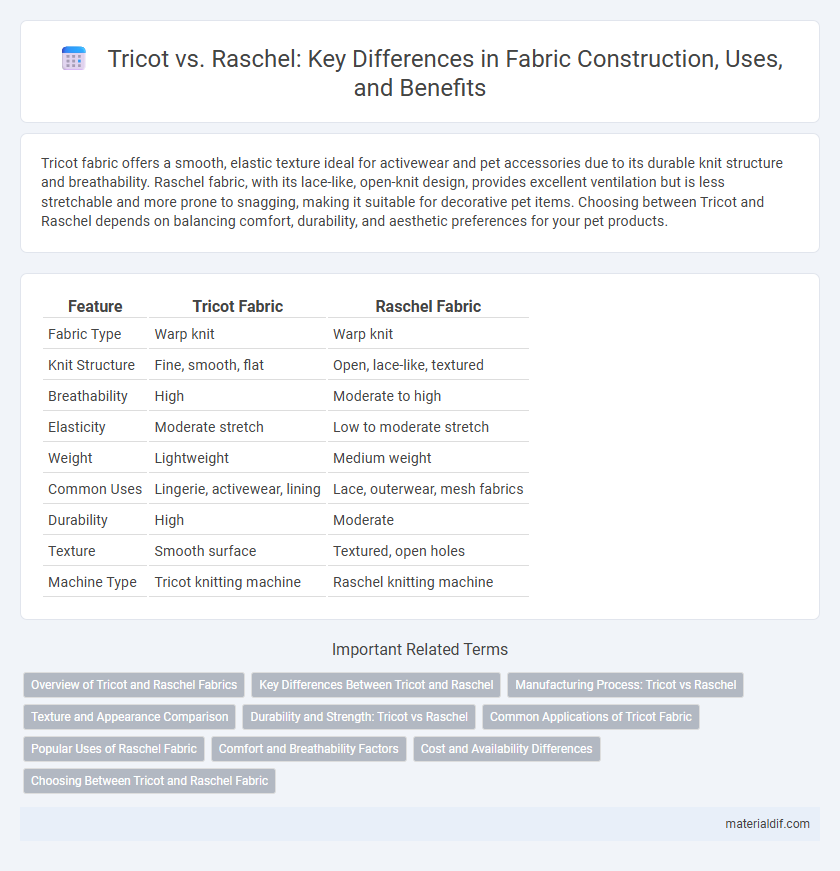Tricot fabric offers a smooth, elastic texture ideal for activewear and pet accessories due to its durable knit structure and breathability. Raschel fabric, with its lace-like, open-knit design, provides excellent ventilation but is less stretchable and more prone to snagging, making it suitable for decorative pet items. Choosing between Tricot and Raschel depends on balancing comfort, durability, and aesthetic preferences for your pet products.
Table of Comparison
| Feature | Tricot Fabric | Raschel Fabric |
|---|---|---|
| Fabric Type | Warp knit | Warp knit |
| Knit Structure | Fine, smooth, flat | Open, lace-like, textured |
| Breathability | High | Moderate to high |
| Elasticity | Moderate stretch | Low to moderate stretch |
| Weight | Lightweight | Medium weight |
| Common Uses | Lingerie, activewear, lining | Lace, outerwear, mesh fabrics |
| Durability | High | Moderate |
| Texture | Smooth surface | Textured, open holes |
| Machine Type | Tricot knitting machine | Raschel knitting machine |
Overview of Tricot and Raschel Fabrics
Tricot fabric, characterized by its fine, smooth texture and high stretchability, is formed through a warp knitting process, making it lightweight and breathable, ideal for activewear and lingerie. Raschel fabric, also produced by warp knitting, features a heavier, more textured surface with intricate patterns and higher durability, commonly used in lace, upholstery, and outerwear. Both fabrics offer unique structural benefits, with Tricot favoring softness and elasticity, while Raschel excels in decorative designs and robust performance.
Key Differences Between Tricot and Raschel
Tricot fabric is characterized by its smooth, fine, and soft texture with excellent elasticity, commonly used in lingerie and activewear, while Raschel fabric features a more open, lace-like knit with decorative patterns, often utilized in outerwear and home textiles. Tricot is produced on a flatbed knitting machine, resulting in a tight, warp-knit construction, whereas Raschel is made on a Raschel knitting machine, allowing for intricate designs and more varied openwork. The key differences lie in Tricot's lightweight, breathable quality and Raschel's thicker, more textured feel with enhanced decorative versatility.
Manufacturing Process: Tricot vs Raschel
Tricot fabric is produced using a warp knitting process involving fine yarns interlaced in a smooth, consistent pattern, resulting in a lightweight, stretchable textile ideal for lingerie and activewear. Raschel fabric is created with a more complex warp knitting technique incorporating larger yarns to form intricate, often open designs like lace, nets, or textured patterns, suitable for decorative and technical applications. The key manufacturing difference lies in tricot's fine gauge and simplicity, whereas raschel employs a coarser gauge with multifilament yarns and patterns, affecting fabric strength, elasticity, and appearance.
Texture and Appearance Comparison
Tricot fabric features a smooth, fine texture with a soft, slightly elastic surface ideal for intimate apparel and activewear. Raschel fabric has a more textured, open-knit appearance with a varied pattern, often resembling lace, making it popular for decorative and outerwear uses. The denser, uniform structure of Tricot contrasts with the intricate, mesh-like design of Raschel, influencing both the tactile feel and visual appeal in garment construction.
Durability and Strength: Tricot vs Raschel
Tricot fabric, with its fine, smooth knit structure, offers excellent durability and superior tensile strength, making it resistant to wear and tear over prolonged use. Raschel fabric, characterized by its open, lace-like knit, tends to be less durable and weaker compared to Tricot, as its larger loops are more prone to snagging and stretching. For applications requiring robust and long-lasting materials, Tricot is generally preferred due to its tighter knit and higher fabric integrity.
Common Applications of Tricot Fabric
Tricot fabric is widely used in activewear, lingerie, and swimwear due to its smooth texture, flexibility, and excellent stretch recovery, making it ideal for close-fitting garments that require comfort and durability. Its fine, tightly knit structure provides breathability and moisture-wicking properties, which enhance performance in sportswear and undergarments. Compared to Raschel, Tricot offers a softer hand feel and greater elasticity, favoring applications where flexibility and softness are essential.
Popular Uses of Raschel Fabric
Raschel fabric is widely used in producing netting, lace, and sportswear due to its open, porous structure and high durability. Its robust knit construction makes it ideal for creating sturdy mesh fabrics for industrial applications and fashion accessories. Compared to tricot, Raschel fabric excels in producing intricate patterns and textured designs often seen in lingerie and decorative textiles.
Comfort and Breathability Factors
Tricot fabric features a smooth, soft texture and excellent stretch, providing superior comfort for activewear and lingerie. Raschel fabric, known for its open, lace-like knit, offers enhanced breathability but may feel less soft against the skin. Choosing between tricot and raschel depends on the desired balance between comfort and airflow for specific apparel purposes.
Cost and Availability Differences
Tricot fabric typically costs more than Raschel due to its finer knit and higher production complexity, impacting its availability mostly to specialized markets. Raschel fabric offers a more affordable option and wider availability, favored in mass-produced textiles such as lace and mesh. Manufacturing efficiency and material use in Raschel contribute to its cost-effectiveness and accessibility compared to the premium nature of Tricot.
Choosing Between Tricot and Raschel Fabric
Tricot fabric offers a smooth, lightweight texture with excellent stretch and breathability, making it ideal for activewear and lingerie. Raschel fabric provides a more textured, open-knit design with enhanced durability and decorative patterns, commonly used in outerwear and lace garments. Selecting between Tricot and Raschel depends on the desired fabric elasticity, texture, and end-use application for optimal performance and comfort.
Tricot vs Raschel Infographic

 materialdif.com
materialdif.com